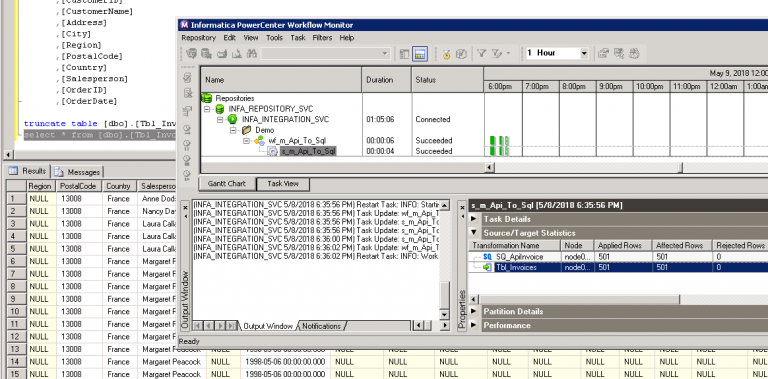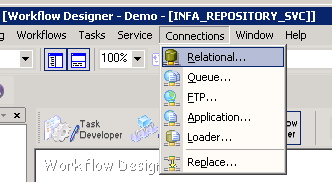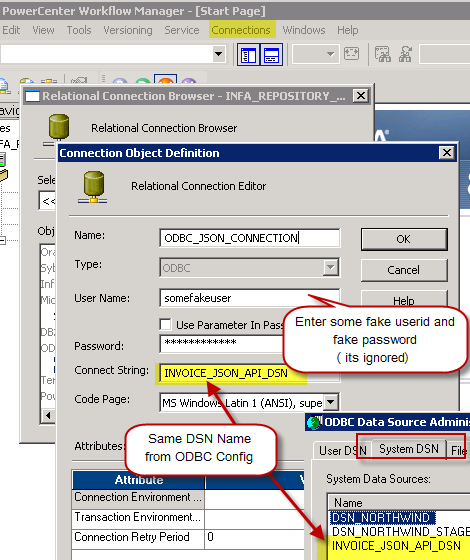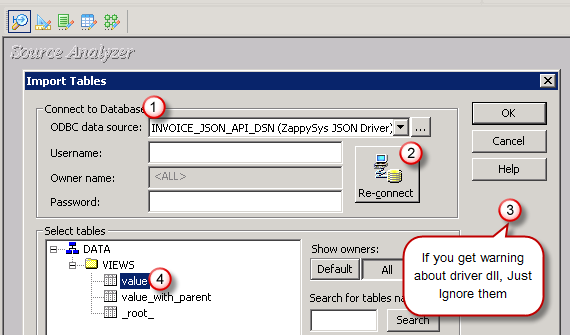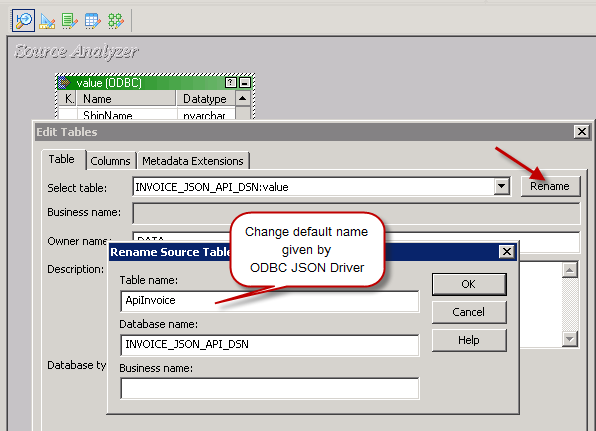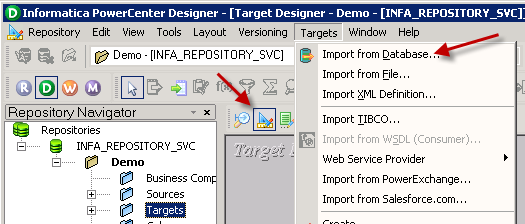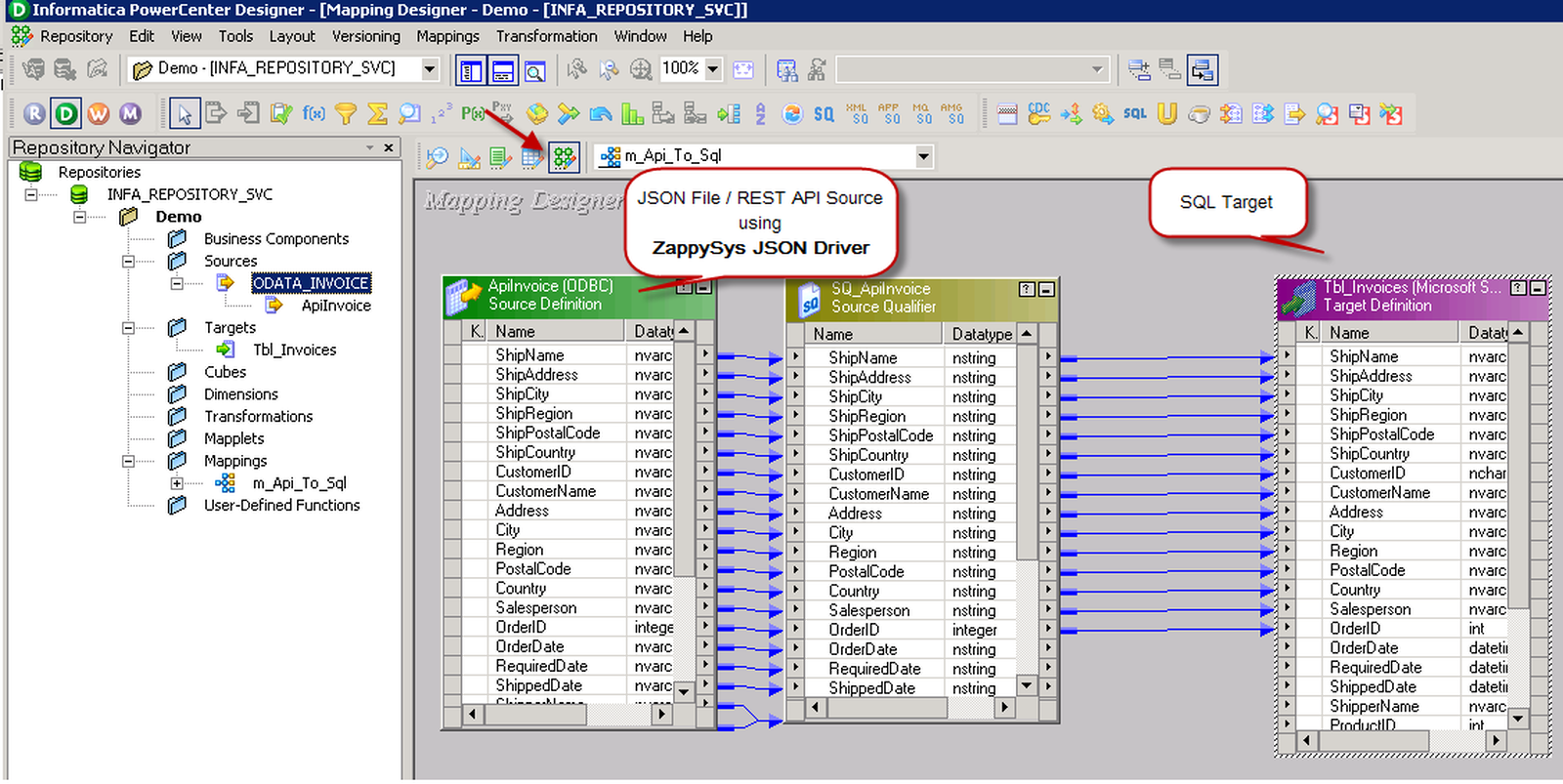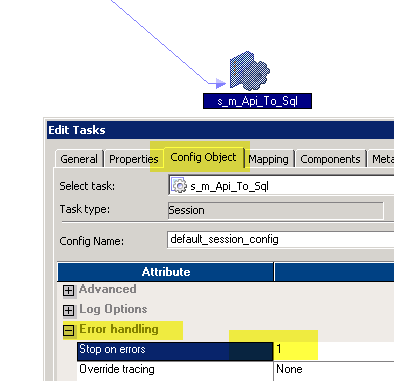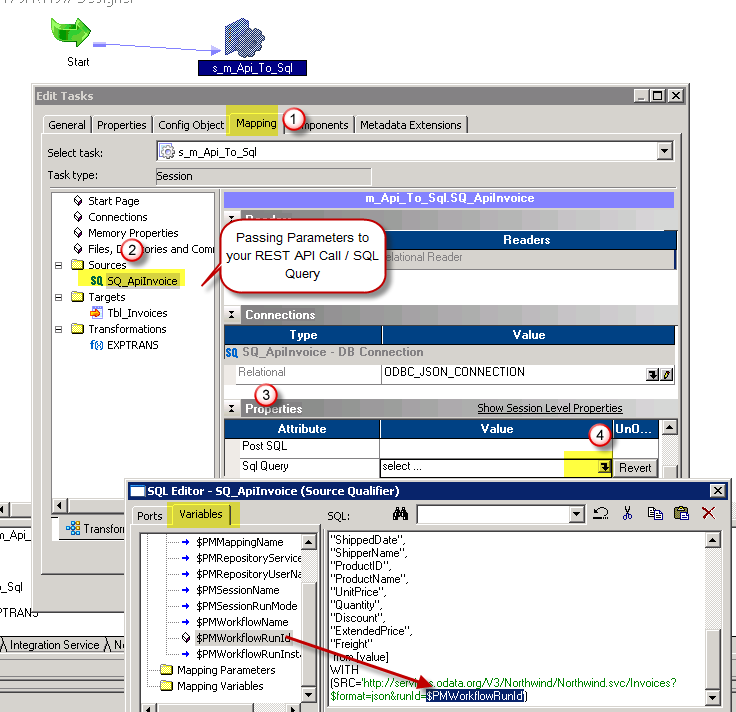|
In this article you will learn how to integrate Using Hubspot Connector you will be able to connect, read, and write data from within Informatica. Follow the steps below to see how we would accomplish that. The driver mentioned above is part of ODBC PowerPack which is a collection of high-performance Drivers for various API data source (i.e. REST API, JSON, XML, CSV, Amazon S3 and many more). Using familiar SQL query language you can make live connections and read/write data from API sources or JSON / XML / CSV Files inside SQL Server (T-SQL) or your favorite Reporting (i.e. Power BI, Tableau, Qlik, SSRS, MicroStrategy, Excel, MS Access), ETL Tools (i.e. Informatica, Talend, Pentaho, SSIS). You can also call our drivers from programming languages such as JAVA, C#, Python, PowerShell etc. If you are new to ODBC and ZappySys ODBC PowerPack then check the following links to get started. |
See also
|
How to read API data in Informatica (Call JSON / XML SOAP Service)
How to write data to API (POST) in Informatica (Call JSON / XML SOAP Service)
Introduction

After going through this article you will learn how to Read Hubspot / JSON / REST API data in Informatica and understand the concept of JSON / REST API. We will go through many screenshots and step-by-step examples to demonstrate Hubspot or REST API integration in Informatica PowerCenter.
XML / JSON can come from a local file or REST API service (internal or public) so we will include both examples in this article (i.e. Read JSON files in Informatica, Import REST API in Informatica). So let’s get started. Next article will focus on how to write data to API in Informatica (POST / PUT data)
Requirements
This article assumes that you have full filled following basic requirements.
- Download Install ZappySys ODBC PowerPack (API Driver for Hubspot included)
- Install Informatica PowerCenter Client Tools (e.g. Workflow and Mapping Designers)
- Access to a Relational database such as SQL Server (or use any of your choice e.g. Oracle, MySQL, DB2 ). If nothing available then you can use flat file target.
High level Steps for Import Hubspot data using Informatica (Read Hubspot API data)
Before we dive deep to learn how to load Hubspot data in Informatica (i.e. Hubspot to SQL Table), Here the summary of high-level steps you need to perform to import Hubspot in Informatica (same steps for Import JSON / XML / REST API).
- Download and Install ZappySys API Driver (for connecting to Hubspot)
- Create ODBC DSN using ZappySys API driver and choose Hubspot Connector during Wizard
- Create Relational > ODBC Connection in Informatica Workflow designer (Point to DSN we created in the previous step)
- Import Hubspot Source Definition in the Informatica Mapping Designer > Sources Tab
- Import Target Table Definition in the Informatica Mapping Designer > Targets Tab
- Create source to target mapping in Mappings tab
- Save mapping (name m_API_to_SQL_Load )
- Create Session using the mapping we created in the previous step
- Save Workflow and execute to load Hubspot data into SQL Table. Verify your data and log.
Video Tutorial – Read any API / JSON data in Informatica (Load Hubspot to SQL Table)
Below video is not about Hubspot API but its showing API access in general (for any API). By watching following ~5 min video can learn steps listed in this article to load JSON API data into SQL Server Table using ZappySys JSON Driver. You can go though full article to learn many useful details not covered in this video.
Getting Started – Import Hubspot to SQL Server in Informatica
Now let’s get started. For example purpose, we will read data from Hubspot and load data into SQL Server Table using Informatica Workflow.
Create ODBC Data Source (DSN) based on ZappySys API Driver
To get data from Hubspot using Informatica we first need to create a DSN (Data Source) which will access data from Hubspot. We will later be able to read data using Informatica. Perform these steps:
-
Install ZappySys ODBC PowerPack.
-
Open ODBC Data Sources (x64):
-
Create a User Data Source (User DSN) based on ZappySys API Driver
ZappySys API DriverYou should create a System DSN (instead of a User DSN) if the client application is launched under a Windows System Account, e.g. as a Windows Service. If the client application is 32-bit (x86) running with a System DSN, use ODBC Data Sources (32-bit) instead of the 64-bit version. -
When the Configuration window appears give your data source a name if you haven't done that already, then select "Hubspot" from the list of Popular Connectors. If "Hubspot" is not present in the list, then click "Search Online" and download it. Then set the path to the location where you downloaded it. Finally, click Continue >> to proceed with configuring the DSN:
HubspotDSNHubspot -
Now it's time to configure the Connection Manager. Select Authentication Type, e.g. Token Authentication. Then select API Base URL (in most cases, the default one is the right one). More info is available in the Authentication section.
Authenticate using static AccessToken (Private App) to access specific account. Follow 3 simple steps. 1) Create an App, 2) select permissions and 3) get Token and use on this UI. For more information on how to obtain AccessToken visit https://developers.hubspot.com/docs/api/private-apps [API Help..]
Steps to get Hubspot Credentials
Just follow this link on how to get an PrivateApp Access Token. Once you obtain it, paste it into AccessToken parameter: https://developers.hubspot.com/docs/api/private-apps
Fill in all required parameters and set optional parameters if needed:
HubspotDSNHubspotPrivate App (Static Access Token) [Http]https://api.hubapi.comRequired Parameters AccessToken Fill in the parameter... Optional Parameters RetryMode Fill in the parameter... RetryStatusCodeList Fill in the parameter... RetryCountMax Fill in the parameter... RetryMultiplyWaitTime Fill in the parameter... OAuth App must be created in HubSpot website. These settings typically found here https://developers.hubspot.com/docs/api/working-with-oauth. [API Help..]
Steps to get Hubspot Credentials
Just follow this link on how to create an API app: https://developers.hubspot.com/docs/api/creating-an-app On the App Scopes section make sure to select following scopes in order to access all features of this driver. You can choose more or less but keep in mind to select same or less number of scopes on Driver UI (Scopes Property) else it will not authorize the request. If you need File Upload feature then choose files scope.
Your selected scopes when registering your app must match the scopes you enter here on the connector screen. You cannot request less or more scopes for now (it may change in future). If they don't match, the connector will not be able to work with your HubSpot account!accounting tickets files ------------------ crm.lists.read crm.lists.write ------------------ crm.objects.contacts.read crm.objects.contacts.write crm.schemas.contacts.read ------------------ crm.objects.custom.read crm.objects.custom.write crm.schemas.custom.read ------------------ crm.objects.companies.read crm.objects.companies.write crm.schemas.companies.read ------------------ crm.objects.deals.read crm.objects.deals.write crm.schemas.deals.read ------------------ crm.objects.quotes.read crm.objects.quotes.write crm.schemas.quotes.read ------------------ crm.objects.line_items.read crm.objects.line_items.write crm.schemas.line_items.read you can add more... but must select same number of scopes in the connection screen too (Scopes Parameter)
Fill in all required parameters and set optional parameters if needed:
HubspotDSNHubspotUser Credentials (3-Legged) [OAuth]https://api.hubapi.comRequired Parameters UseCustomApp Fill in the parameter... Scope (Must Match with App Scopes) Fill in the parameter... Optional Parameters Client ID Fill in the parameter... Client Secret Fill in the parameter... ReturnUrl Fill in the parameter... RetryMode Fill in the parameter... RetryStatusCodeList Fill in the parameter... RetryCountMax Fill in the parameter... RetryMultiplyWaitTime Fill in the parameter... Authenticate using Static API Key instead of userid / password. It can be found at https://app.hubspot.com/api-key/<YOUR_ACCOUNT_ID>>/call-log [API Help..]
Steps to get Hubspot Credentials
Just follow this link on how to get an API key. Once you obtain it, paste it into ApiKey parameter: https://knowledge.hubspot.com/integrations/how-do-i-get-my-hubspot-api-key
Fill in all required parameters and set optional parameters if needed:
HubspotDSNHubspotAPI Key in URL (Deprecated) [Http]https://api.hubapi.comRequired Parameters ApiKey Fill in the parameter... Optional Parameters RetryMode Fill in the parameter... RetryStatusCodeList Fill in the parameter... RetryCountMax Fill in the parameter... RetryMultiplyWaitTime Fill in the parameter... -
Once the data source has been configured, you can preview data. Select the Preview tab and use settings similar to the following to preview data:
-
Click OK to finish creating the data source.
Create Connection in Informatica Workflow Designer
Once you create DSN using API Driver our next step is to define a connection for Hubspot source in Informatica PowerCenter Workflow designer.
- Open Workflow designer [W] icon
- Goto Connections > Relational
- Click New and select ODBC
- Now on the ODBC connection setup enter connection name, some fake userid / password (this is a required field but its ignored by JSON Driver)
-
In the Connection String field enter the exact same name of DSN (Open ODBC Data Sources UI to confirm)
Configure Hubspot connection in Informatica for REST API – Using ZappySys API Driver
- Click OK to close the connection properties.
That’s it. Now we ready to move to next step (define source and target in Mapping Designer).
Import Hubspot Source Definition in Informatica Mapping Designer
Now let’s look at steps to import Hubspot table definition.
- Open Informatica Mapping Designer (Click [D] icon)
- Click on Source Icon to switch to Sources designer
- From the top menu > Click on Sources > Import from Database …
- Select ODBC data source from the dropdown (Find out DSN we created earlier to use as JSON Source)
-
Click Connect button to get a list of tables. Any array node is listed as a table. Also, you will see array node with parent columns (e.g. value_with_parent). You may get some warning like below but they are harmless so just ignore by clicking OK.
DLL name entry missing from C:\Informatica\PowerCenter8.6.1\client\bin\powrmart.ini Section = ODBCDLL Entry = ZappySys JSON Driver
—————————————————-
Using EXTODBC.DLL to support ZappySys JSON Driver. For native support of ZappySys JSON Driver make an entry in the .ini file. - Select Table you wish to get (You can filter rows by custom SQL query. We will see later in this article how to do)
- Optionally once table structure is imported you can rename it
- That’s it, we are now ready to perform similar steps to import Target table structure in the next section.
Import SQL Server Target Definition in Informatica Mapping Designer
Now let’s look at steps to import Target table definition (very similar to the previous section, the only difference is this time we will select DSN which points to SQL Server or any other Target Server).
Now lets look at steps to import target table definition in Informatica mapping designer.
- In the Mapping Designer, Click on Target Icon to switch to Target designer
- From the top menu > Click on Targets > Import from Database …
- Select DSN for your Target server (if DSN doesn’t exist then create one by opening ODBC Sources just like we created one for JSON API source (see the previous section about creating DSN).
- Enter your userid , password and Schema name and click Connect to see tables
- Select Table name to and click OK import definition.
Create Source to Target Mapping in Informatica (Import JSON to SQL Server)
Once you have imported source and target table definition, we can create mapping and transformation to load data from JSON to SQL Table.
- First open Mapping Designer (Click [D] icon)
- Drag JSON Source from sources folder
- Drag SQL Table from Targets folder
- Map desired columns from Source to target
-
For certain columns you may have to do datatype conversion. For example to convert OrderDate form nstring to DataTime you have to use Expression Transform like below and map it to target. In below example, our JSON has date format (e.g. 2018-01-31 12:00:00 AM ). To import this to DateTime field in SQL server we need to convert it using TO_DATE function. Use double quotes around T to make this format working.
TO_DATE(OrderDate,'YYYY-MM-DD H12:MI:SS AM') --For ISO use below way TO_DATE(OrderDate,'YYYY-MM-DD"T"HH24:MI:SS') - Once you done with mapping save your mapping and name it (i.e. m_Api_To_SQL)
- Now lets move to next section to create workflow.
Create Workflow and Session in Informatica
Now the final step is to create a new workflow. Perform following steps to create workflow which with a session task to import JSON data into SQL table.
- Open workflow designer by click [W] icon.
-
Launch new workflow creation wizard by click Workflow top menu > Wizard
name your workflow (e.g. wf_Api_Tp_Sql_Table_Import) - Finish the wizard and double-click the Session to edit some default properties.
- First change Error settings so we fail session on error (By default its always green)
- Select JSON connection for Source
- Change default Source query if needed. You can pass parameters to this query to make it dynamic.
- Select Target connection of SQL Target Table
- Save workflow
- That’s it. We ready to run our first workflow to load JSON data to SQL.
Execute Workflow and Validate Log in Informatica
Now once you are done with your workflow, execute it to see the log.
POST data to Hubspot in Informatica
There will be a time when you like to send Source data to REST API or SOAP Web Service. You can use below Query for example. For detailed explanation on how to POST data in Informatica check this article.
Video Tutorial – How to POST data to REST API in Informatica
Here is detailed step by step video on REST API POST in informatica PowerCenter
Keywords
how to import Hubspot in informatica | how to read Hubspot data in informatica powercenter | how to test json from informatica | how to use Hubspot data as source in informatica power center | how to connect Hubspot in informatica 10 | informatica how to import data from Hubspot | informatica jtx to import Hubspot (use of java transformation) | informatica plugin for restful api using json | informatica power center and Hubspot support | informatica read Hubspot | informatica rest api | informatica Hubspot connector | json parser import informatica
Create Custom Stored Procedure in ZappySys Driver
You can create procedures to encapsulate custom logic and then only pass handful parameters rather than long SQL to execute your API call.
Steps to create Custom Stored Procedure in ZappySys Driver. You can insert Placeholders anywhere inside Procedure Body. Read more about placeholders here
-
Go to Custom Objects Tab and Click on Add button and Select Add Procedure:
-
Enter the desired Procedure name and click on OK:
-
Select the created Stored Procedure and write the your desired stored procedure and Save it and it will create the custom stored procedure in the ZappySys Driver:
Here is an example stored procedure for ZappySys Driver. You can insert Placeholders anywhere inside Procedure Body. Read more about placeholders here
CREATE PROCEDURE [usp_get_orders] @fromdate = '<<yyyy-MM-dd,FUN_TODAY>>' AS SELECT * FROM Orders where OrderDate >= '<@fromdate>';
-
That's it now go to Preview Tab and Execute your Stored Procedure using Exec Command. In this example it will extract the orders from the date 1996-01-01:
Exec usp_get_orders '1996-01-01';
-
Let's generate the SQL Server Query Code to make the API call using stored procedure. Go to Code Generator Tab, select language as SQL Server and click on Generate button the generate the code.
As we already created the linked server for this Data Source, in that you just need to copy the Select Query and need to use the linked server name which we have apply on the place of [MY_API_SERVICE] placeholder.
SELECT * FROM OPENQUERY([MY_API_SERVICE], 'EXEC usp_get_orders @fromdate=''1996-07-30''')
-
Now go to SQL served and execute that query and it will make the API call using stored procedure and provide you the response.
Create Custom Virtual Table in ZappySys Driver
ZappySys API Drivers support flexible Query language so you can override Default Properties you configured on Data Source such as URL, Body. This way you don't have to create multiple Data Sources if you like to read data from multiple EndPoints. However not every application support supplying custom SQL to driver so you can only select Table from list returned from driver.
If you're dealing with Microsoft Access and need to import data from an SQL query, it's important to note that Access doesn't allow direct import of SQL queries. Instead, you can create custom objects (Virtual Tables) to handle the import process.
Many applications like MS Access, Informatica Designer wont give you option to specify custom SQL when you import Objects. In such case Virtual Table is very useful. You can create many Virtual Tables on the same Data Source (e.g. If you have 50 URLs with slight variations you can create virtual tables with just URL as Parameter setting.
-
Go to Custom Objects Tab and Click on Add button and Select Add Table:
-
Enter the desired Table name and click on OK:
-
And it will open the New Query Window Click on Cancel to close that window and go to Custom Objects Tab.
-
Select the created table, Select Text Type AS SQL and write the your desired SQL Query and Save it and it will create the custom table in the ZappySys Driver:
Here is an example SQL query for ZappySys Driver. You can insert Placeholders also. Read more about placeholders here
SELECT "ShipCountry", "OrderID", "CustomerID", "EmployeeID", "OrderDate", "RequiredDate", "ShippedDate", "ShipVia", "Freight", "ShipName", "ShipAddress", "ShipCity", "ShipRegion", "ShipPostalCode" FROM "Orders" Where "ShipCountry"='USA'
-
That's it now go to Preview Tab and Execute your custom virtual table query. In this example it will extract the orders for the USA Shipping Country only:
SELECT * FROM "vt__usa_orders_only"
-
Let's generate the SQL Server Query Code to make the API call using stored procedure. Go to Code Generator Tab, select language as SQL Server and click on Generate button the generate the code.
As we already created the linked server for this Data Source, in that you just need to copy the Select Query and need to use the linked server name which we have apply on the place of [MY_API_SERVICE] placeholder.
SELECT * FROM OPENQUERY([MY_API_SERVICE], 'EXEC [usp_get_orders] ''1996-01-01''')
-
Now go to SQL served and execute that query and it will make the API call using stored procedure and provide you the response.
Conclusion
In this article we discussed how to connect to Hubspot in Informatica and integrate data without any coding. Click here to Download Hubspot Connector for Informatica and try yourself see how easy it is. If you still have any question(s) then ask here or simply click on live chat icon below and ask our expert (see bottom-right corner of this page).
Download Hubspot Connector for Informatica
Documentation
Actions supported by Hubspot Connector
Hubspot Connector support following actions for REST API integration. If some actions are not listed below then you can easily edit Connector file and enhance out of the box functionality.| Parameter | Description |
|---|---|
| Properties |
|
| Parameter | Description |
|---|---|
| Properties |
|
| Parameter | Description |
|---|---|
| Properties |
|
| Parameter | Description |
|---|---|
| Properties |
|
| Parameter | Description |
|---|---|
| Properties |
|
| Parameter | Description |
|---|---|
| Properties |
|
| Parameter | Description |
|---|---|
| Properties |
|
| Parameter | Description |
|---|---|
| Properties |
|
| Parameter | Description |
|---|---|
| Properties |
|
| Parameter | Description |
|---|---|
| Properties |
|
| Parameter | Description |
|---|---|
| Properties |
|
| Parameter | Description |
|---|---|
| Properties |
|
| Parameter | Description |
|---|---|
| Properties |
|
| Parameter | Description |
|---|---|
| Properties |
|
| Parameter | Description |
|---|---|
| Properties |
|
| Parameter | Description |
|---|---|
| Properties |
|
| Parameter | Description |
|---|---|
| Properties |
|
| Parameter | Description |
|---|
| Parameter | Description |
|---|
| Parameter | Description |
|---|---|
| Properties |
|
| Parameter | Description |
|---|---|
| Properties |
|
| Parameter | Description |
|---|
| Parameter | Description |
|---|---|
| Properties |
|
| Parameter | Description |
|---|---|
| Properties |
|
| Parameter | Description |
|---|
| Parameter | Description |
|---|---|
| OwnerId |
|
| Parameter | Description | ||||||||
|---|---|---|---|---|---|---|---|---|---|
| Source File Path |
|
||||||||
| Target Folder Path |
|
||||||||
| Target File Name (e.g. MyFile.xlsx) |
|
||||||||
| AccessType |
|
||||||||
| Overwrite |
|
||||||||
| DuplicateValidationStrategy |
|
||||||||
| DuplicateValidationScope |
|
| Parameter | Description |
|---|---|
| Url |
|
| Body |
|
| IsMultiPart |
|
| Filter |
|
| Headers |
|
This page offers a collection of SQL examples designed for seamless integration with the ZappySys API ODBC Driver under ODBC Data Source (36/64) or ZappySys Data Gateway, enhancing your ability to connect and interact with Prebuilt Connectors effectively.
Get companies [Read more...]
Gets companies
SELECT * FROM Companies --Where Id=123Get contacts [Read more...]
Gets contacts
SELECT * FROM Contacts --Where Id=123Get contact by Id [Read more...]
Gets contact by Id
SELECT * FROM Contacts Where Id=51Get contact by email (search) [Read more...]
Gets contacts
SELECT Id
, IsArchived
, CreatedAt
, UpdatedAt
, email
, firstname
, lastname
, company_size
--, custom_checkbox
--, custom_multi_select
--, custom_number
--, custom_pickuser
--, custom_richtext
--, custom_string
--, custom_string_multi
FROM search_contacts
With(SearchFilters='[ {"propertyName": "email", "operator": "EQ", "value": "bh@hubspot.com" } ]')Get deals [Read more...]
Gets deals
SELECT * FROM Deals --Where Id=123Get line items [Read more...]
Gets line items
SELECT * FROM LineItems --Where Id=123Get owners [Read more...]
Gets owners
SELECT * FROM OwnersGet products [Read more...]
Gets products
SELECT * FROM Products --Where Id=123Get tickets [Read more...]
Gets tickets
SELECT * FROM TicketsGet quotes [Read more...]
Gets quotes
SELECT * FROM QuotesGeneric Request (Company Search API Example) [Read more...]
This example shows how to invoke generic request when connector file doesnt have specific EndPoint / Table you like to query. This example invokes search endpoint but you can call any valid API endpoint GET/POST etc with this method
SELECT *
FROM generic_request
WITH(
Url='crm/v3/objects/companies/search'
,Filter='$.results[*]'
,RequestContentTypeCode='ApplicationJson'
,RequestMethod='POST'
,RequestData='{
"filters": [ {"propertyName": "hs_lastmodifieddate", "operator": "GT", "value": "<<yearstart-1y||unix_timestamp_ms,FUN_TO_DATE>>" } ],
"properties": ["address","city","state"]
}'
)Upload File (Generic Request Example) [Read more...]
This example shows how to upload a file using generic request. You might have to add file-manager-permission to your OAuth App else you might get message=This oauth-token (CJT87I6) does not have proper permissions! (requires any of [file-manager-access]). For more information please refer to this link https://developers.hubspot.com/docs/api/files/files
SELECT *
FROM generic_request
WITH(
Url='filemanager/api/v3/files/upload'
, RequestMethod='POST'
, Filter ='$.objects[*]'
, Body='file=@c:\temp\dump.png
folderPath=/
fileName=my_dump.png
options={"access": "PRIVATE", "overwrite": true}'
, IsMultiPart='True'
, Meta='id:long; name:string; title:string; url: string; type:string; size:long; friendly_url:string; meta.allows_anonymous_access:string; meta.indexable:bool'
)Insert into Contacts [Read more...]
Inserts contacts
INSERT INTO Contacts(email, firstname, lastname,custom_checkbox, custom_date, custom_number)
VALUES ('john.doe@abc.com', 'John', 'Doe','true','2023-01-01', 100.55)Update Contacts [Read more...]
Updates contacts in your account
UPDATE Contacts
SET firstname = 'Brian'
,lastname = 'Halligan (Sample Contact)'
--,custom_number=12.12
--,custom_date='2023-01-01'
--,custom_string='My Test<<FUN_NOW>>'
--,custom_richtext='<p><span style="color: #b5b5b5;">##-Please reply-##</span></p>'
--,custom_multi_select='Blue;Yellow;Black'
--,custom_pickuser=45581955
--,custom_dropdown='BB'
--,custom_checkbox='true'
WHERE Id = 51Delete a contact [Read more...]
Deletes a contact
DELETE FROM Contacts Where Id=1234Create multiple records - (BULK read / write from external source) [Read more...]
This examples shows how to perform bulk update using SOURCE clause. It reads data from external system (in this example MS SQL Server) and sends data to Hubspot using Bulk API
INSERT INTO Contacts
SOURCE(
'MSSQL' --ODBC or OLEDB
,'Data Source=localhost;Initial Catalog=Test;Integrated Security=true'
,'
''bob'' as firstname, ''rock'' as firstname, ''new-email1@abc.com'' as email
UNION
''sam'' as firstname, ''smith'' as firstname, ''new-email2@abc.com'' as email
)Delete multiple records - (BULK read / write from external source) [Read more...]
This examples shows how to perform bulk delete using SOURCE clause. It reads data from external system (in this example MS SQL Server) and sends data to Hubspot using Bulk API
DELETE FROM Contacts
SOURCE(
'MSSQL' --ODBC or OLEDB
,'Data Source=localhost;Initial Catalog=Test;Integrated Security=true'
,'select 104897 as Id
UNION
select 104898 as Id'
)Update multiple records - (BULK read / write from external source) [Read more...]
This examples shows how to perform bulk update using SOURCE clause. It reads data from external system (in this example MS SQL Server) and sends data to Hubspot using Bulk API
UPDATE Contacts
SOURCE(
'MSSQL' --ODBC or OLEDB
,'Data Source=localhost;Initial Catalog=Test;Integrated Security=true'
,'select 104811 as Id, ''new-email1@abc.com'' as email
UNION
select 104812 as Id, ''new-email2@abc.com'' as email
)Other App Integration scenarios for Hubspot
Other Connectors for Informatica
Download Hubspot Connector for Informatica
Documentation
How to connect Hubspot in Informatica? How to get Hubspot data in Informatica? How to read Hubspot data in Informatica? How to load Hubspot data in Informatica? How to import Hubspot data in Informatica? How to pull Hubspot data in Informatica? How to push data to Hubspot in Informatica? How to write data to Hubspot in Informatica? How to POST data to Hubspot in Informatica? Call Hubspot API in Informatica Consume Hubspot API in Informatica Hubspot Informatica Automate Hubspot Informatica Integration Integration Hubspot in Informatica Consume real-time Hubspot data in Informatica Consume real-time Hubspot API data in Informatica Hubspot ODBC Driver | ODBC Driver for Hubspot | ODBC Hubspot Driver | SSIS Hubspot Source | SSIS Hubspot Destination Connect Hubspot in Informatica Load Hubspot in Informatica Load Hubspot data in Informatica Read Hubspot data in Informatica Hubspot API Call in Informatica
